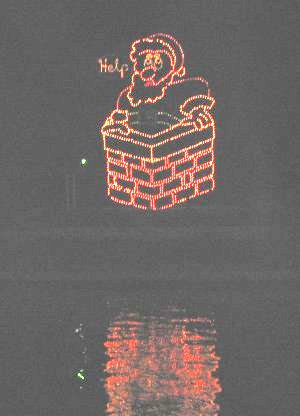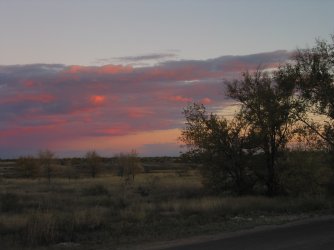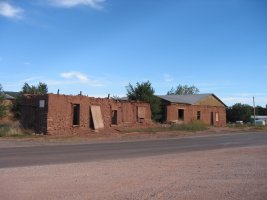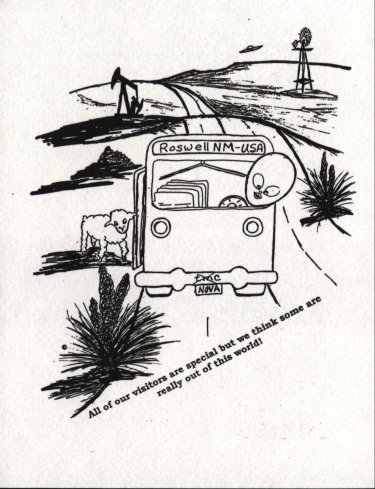CHRISTMAS ON THE PECOS
RWM
“Christmas on the Pecos glows out of the desert and reflects the magic of the holiday season,” states the Carlsbad Chamber of Commerce website.

The Pecos River flows by Carlsbad, seemingly in abundance (despite the concerns of Pecos River water users), thanks to that community’s irrigation and recreation project begun years earlier. About 10 years ago, the idea of Christmas on the Pecos was born.

There the water is wide and deep, and in that area of the Pecos River, the straight steep banks are clearly defined and man-made of concrete, and have boat docks. It appears more like an inland canal, where one might expect to see locks and goods-bearing ships from the sea, rather than a portion of a river that runs through arid New Mexico. One excursion boat traveler estimated the width of the man-made river in that area to be that of perhaps half of a football field.
Rather than goods, its barges or ferries transport people. They are actually pontoon excursion boats, three of which nightly carry passengers into the magic of Christmas during its extended holiday season. With exception of Christmas Eve, the cruises run, 12 each night, beginning Thanksgiving through New Year’s Eve.

The excursion boats depart from the brightly lit and imaginatively decorated Pecos River Village, from a dock on the east riverbank. This holiday season, an estimated 17,000 people will take the night-time riverfront excursion that, like its world-renowned Caverns, is unique to Carlsbad, New Mexico.
For about 50 minutes, as many as 30 or 40 people on each boat, bundled up cozily in coats and blankets on seats under a canopy roof, gaze out all sides of the open boat at the wondrous sights, doubly seen as they are reflected upon the tranquil water. Except for recorded Christmas music played by the boatman, the air is still and quiet as Christmas travelers slowly float in silent awe past the multitude of larger-than-life scenes on the waterfronts of both sides. The brightly lit settings, reflecting many different holiday themes and interpretations, vary from religious to humorous.

There is a display of giant Indian Kachina dolls, American flags and other patriotic themes, Santa depicted in many guises and on various conveyances including pony and stagecoach, all of the traditional Christmas scenes and motifs including Bethlehem and nativity scenes, as well as the Chanukah Menorah and the Star of David to welcome those of Jewish faith. Season’s greetings of all kinds — including “Welcome to Christmas on the Pecos,” and “God bless us everyone” — hail waterway travelers into the joyous realms of Christmas.
Approximately 100 participating property owners along the Pecos Riverfront, as well as hundreds of community volunteers, together spend a full year planning, designing and making the fantastic scenes that yearly wow appreciative audiences. Christmas on the Pecos has become a holiday tradition in southeastern New Mexico, and the American Bus Association has named it one of the top 100 must-sees in North America.

Visit their website at http://www.christmasonthepecos.com/ for more awe-inspiring photos, or call 505-887-6516 for reservations. Depending upon the night of the week, tickets vary from $5 to $9 for each holiday traveler. Carlsbad Chamber of Commerce is your primary host when visiting Christmas on the Pecos.
RWM
by Jan Girand

(Sunflowers along Bonny Ditch, dug approximately 1841 in NENM)
As I walked down the lonely road
of rust and ocher — colors showed
New Mexico’s tones — the strokes were bold,
from autumn’s palette, red and gold.

(Autumn color along the Pecos River near Villanueva)
The scents of sage and prickly pear
rose up to greet me, filled the air
with pungent smells of dust and seed
and sunflower stalks and cabbage weed.

The sunset spread its dripping hues
of rosy orange, vermillion, blues —
like crayons melting in the light,
de colores ran before the night.
The glow gave light for me to see
great forests of antiquity;
the mighty oaks bowed down to nod
while begging blessings from their God.

(Deer near Timberon, photo by Carol Bignell)
I hear the cry of a mourning dove
sob of unrequited love ;
the aspens quaked in evening’s light
and pines stood brave against the night.

(Villanueva)
At last I found the place I sought:
a silent village long forgot
and left behind so long before —
the final close of a heavy door
on times of carts by oxen pulled
and wheel-spun threads and carded wool
and calico and tatted lace
and patch-work quilts about the place.

(Ditch dug by James Bonney, about 1841, for his ranch and trading post along the Santa Fe Trail. Col Alexander W. Doniphan and his Missouri Volunteers, and Gen. Stephen Watts Kearny and his Army of the West, spent nights along here as guests of Bonney about August 14, 1846 on their conquest trek of New Mexico and California. There is no doubt Ceran St. Vrain also visited here many times. James Bonney was killed by Indians in October, 1846)
St. Vrain and Kearney and their kin,
land grantees and mountain men,
had passed this way,
their aura spills;
their echoes call down from ancient hills.
A timeless adobe squats in dust:
an old man telling his beads at dusk;
the faded manta falls away
to bare a face of time-worn clay —
was sculpt and smoothed so long ago
by the expert hands of El Senor.

(Villanueva)
The time has ravaged countenance,
and gentle pride has bowed its stance,
yet … adobe of those bygone days
retains its charm in other ways;
those softened lines of melted earth,
like tarnish on silver, proves its worth.

(Villanueva)
An old ghost town that’s gone to seed
is wrapped up now in tangled weeds;
small children’s laughter, woman’s song
once filled the air but now are gone.
Still, signs of life, however faint …
against a wall with faded paint,
in all their glory bloom some stalks
of gold and crimson hollyhocks.
O’er there’s an orchard, mostly dead,
but on one tree are spots of red
and on another, in mid-air,
delicious apples dangle there.

(Inside, looking out, of what had been the home of Cleofas Bonney Lopez)
The well’s gone dry and stock pond too,
all roofs caved in, whole walls are few
The paneless eyes stare sightlessly
midst tumbled bricks and piled debris.
Where once were homes, there’s little left;
those dirt-tracked floors are now windswept.
Just over there a fireplace stands:
a lonely shape in a lonely land.
Adobe needs life, its care a must
or effort-laid bricks return to dust;
erosion and melt of wind and rain
return it back from where it came.

(A roadside bulto/Santo at Villanueva)
The warmth of sun that soon must go
still lends its light, a haloed glow,
so on I walk the winding road
over the trail that others strolled.
The camposanto’s silence keeps
its field of dreamers’ endless sleep.
The wooden crosses, daubed with white
are goss’mer figures in twilight.

Cemetery at Tinnie near Lincoln
Ah … looming now a church here stands,
was frost with mud by worn brown hands
with loving care, yes, even today
yet chunks of it have fallen away.
An arched bell-tower high above
is just a place for roosting doves,
for long ago, the story’s told,
the bell was taken for its gold.
The battered walls are two-foot thick,
they’re doubled walls of mudded brick,
two-centuries old and arid-cured,
yet gracefully they have endured.
A deep-set window, linteled doors,
inside I know are tamped-dirt floors.
Now walls are mauve as breast of dove,
from twilit glow, like hills above.
Some sparks of light reflect on walls —
a myth from books, I now recall,
of golden cities of long ago …
small flecks of mica cause the glow!
The hand-hewn vigas through walls jut
above the doors that had been cut
by artisanos’ loving skill
so long ago, yet flawless still.
A home of God, a holy place,
serenity and solemn grace …
but also used for other things,
like a retreat from life’s sharp stings.
Those massive walls for years withstood
the raging battles, fire and flood
and hails of spears by Indian raids.
It also saw shy blushing maids
who walked along that narrow aisle,
escorted by Patrone’s smile
and Mama’s tears and sister’s sigh.

(St. Patrick’s at San Patricio in the Hondo Valley)
That brass-toned bell rang joy on high
up in the loft; it rang before
to warn townsfolk to bar the door.
That missing bell once had its day
imparting news the timeless way.
Rejoicing, joyous tones of cheer,
or warning, calling people here,
or mourning, crying tolling sad …
back then that bell was all they had.
Now, in the autumn twilight air
I sense some things that are not there;
a glimpse of people, things I feel,
a paradox — unreal yet real.
Imagined voice I hear within,
“Forgive me Father, I have sinned …”
I slip within this hallowed place
of peacefulness and holy grace.
Here’s wooden seats in hollow halls,
and old retablos line the walls.
Some ghosts of souls still linger here …
my imagination, I’ve no fear.
Faint pinon incense greets my nose
and flick’ring candles’ brilliance grows.

(Interior of the church at Lincoln)
Soft ageless voices (seems to me)
sing “Gloria” in harmony.
In satin gown, colores rich,
the carved Maria’s in her niche;
below her feet I think I see …
“Mi santa Madre, plead for me …”
The votive candles’ softened glow
casts wisps of light; I do not know
if all I see is really there …
it matters not, I do not care.
If spirits bide, I feel they’re kin;
old friends to me for years they’ve been.
This haven of my gentle ghosts
is the sanctuary I love most.
Conquistadors’ old mysteries
and Sangre de Cristo majesties
still lend their sense of solitude
within this mountain interlude.
I’ve stepped into pine-scent air
and fragrant breezes chased all care.
Must leave this place of brief repast,
the sun is down and moon is cast
against the sky of velvet drape.
I hear an owl, see trees’ vague shapes.

(Photo by JoAnn Hazel taken at Bitter Lakes)
“KA BOOM!” A noise above me bursts.
It frightens birds and shakes the earth!
That dissonanting sound of might
(a jet-fueled plane that rents the night)
returns me back to where I was not
to age of moon-walk astronaut.
Yet, in New Mexico, if you look —
like in a beloved picture book —
you’ll see the remnants left behind:
a land of years (tierra de ayer) where time’s been kind.

(Sunset photo taken by JoAnn Hazel of Roswell)
With BioChoice SLIM, you can reduce the amount of fat absorbed by your body. Betasanne, the patented ingredient in BioChoice SLIM, is a fast-acting, natural way to maintain a healthy weight. When taken properly, Betasanne absorbes fat without inhibiting digestive enzymes. You may take it before, during or after a meal.
BioChoice SLIM is
* Fast-acting;
* Contains no stimulants;
* Absorbs fat;
* Promotes weight management;
* Is completely natural,
* Sugar-free; and
* Doesn’t alter your body chemistry.
Precaution for those with seafood allergies: Shellfish is the source for Betassane in BioChoice SLIM.
Email jan@themail.us or call 505-623-0640 to order yours today.
CONTINUING TO EXPLORE THE ORIGINS OF “BILLY THE KID” BONNEY

Pictured above is an old adobe Bonney abode, built in the 1800s, as it now looks at the beginning of the new millennium. It is on private property in northeastern New Mexico, and was the residence of Santiago (Hispanic for James) Bonney, the son of a blue-eyed Englishman named James Bonney. At least one historian thinks that James Bonney was a close relative of Billy “the Kid.”
Continuation of A Bonney Ballad by Jan Girand
So … who was our Henry McCarty, William H. Bonney, “The Kid?”
Where did he come from, who was his ma, why did he do what he did?
Of his latter years (alas, so few), we know his story well
for many, including Pat Garrett, his stories loved to tell.
His antics, shoot-outs, hot pursuits are documented well
in books, in movies and in songs, stretched out so they would sell.
And sell they did, even in England, for folks there love a tale —
of strife, romance and intrigue as they quaff their brew and ale.
***
… to be continued …
(To see earlier portions of this poem, click the Archives button and go to Byway pages of the previous issues.)
Pictured below is the Santiago Bonney Ditch as it appears today, more than 150 years after it was dug in northeast New Mexico by Englishman James Bonney in 1845 near his home and trading post along the Santa Fe Trail at a place then called La Junta, “the junction,” so-named because of the convergence of rivers.
In late summer of 1846, during their successful expedition in conquest of New Mexico and California for the U.S., Col. Stephen Watts Kearney and his Army of the West, and Col. Alexander W. Doniphan and his troops and caissons, camped at La Junta as guests of James Bonney, who supplied them his choicest beef. A few months later, Bonney was killed by Indians when he went in pursuit of them to retrieve his stolen horses. He went alone except for his young Indian guide, and took his wife’s fresh-baked tortillas for barter. That was a fatal mistake.
Santiago Bonney Ditch
The origins and genealogy of Billy “The Kid” Bonney and his early life remain a mystery. So too is the mystery of why he, in the latter portion of his short life, adopted the name Bonney. Most published historians think that: a.) He began life in New York as Henry McCarty; b.) He changed his name to William Henry Antrim to match his stepfather’s after his mother’s marriage in Santa Fe in 1873; and c.) He adopted the name William H. or Billy Bonney in the last years of his life. Historians don’t know from where he acquired or why he adopted the Bonney name. Serious historians admit that they are uncertain of his origins, but think he might have been born in a New York City Irish slum in 1859. Both the place and the date of his birth could be incorrect.
We will continue to explore the possibilities together in future issues.
Rwm
Send an Email to editor@roswellwebmag.com , giving your Email address and your mailing address, and we will mail this (below) collector postcard to you with a Roswell, New Mexico cancellation stamp.

“All of our visitors are special, but we think some are really out of this world!”
Rwm
 Roswell Web Magazine
Roswell Web Magazine